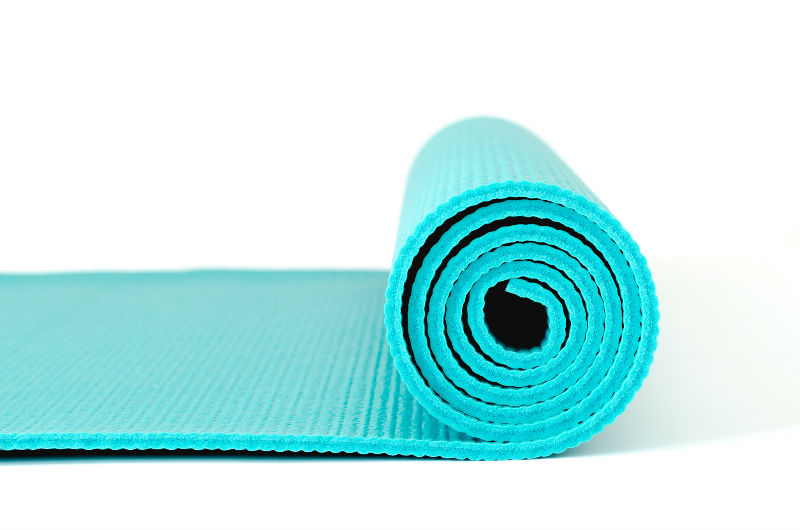Yoga as You Age: The Benefits of Relaxation and Exercise in Treating Insomnia and Anxiety
May 10, 2017 - Viewpoints
by Samantha Relich for Choosing Wisely Canada
A patient story highlighting the benefits of yoga for older adults in treating insomnia and anxiety.
Yoga as You Age: The Benefits of Relaxation and Exercise in Treating Insomnia and Anxiety
May 10, 2017 - Viewpoints
by Samantha Relich for Choosing Wisely Canada
A patient story highlighting the benefits of yoga for older adults in treating insomnia and anxiety.

The lighting is dim and soft music fills the air as a soothing voice guides the class through a series of positions. The motions of the warrior sequence are familiar, even though in this yoga class there are no mats.
In the farthest corner of the room, Margaret, a participant, gingerly shifts her hold on the back of the chair in front of her as she deepens her stretch. The purple karate belt that will be used to aid later poses slips from the chair to the floor.
The chairs and belts are not the rarities in this practice. The average age of the participants here is 85. Margaret is 92.
“I don’t like to say aged, I prefer to say mature,” says instructor Lee O’Neill, describing the demographic that her company Golden Years Yoga caters to. As the name suggests, her services are geared primarily toward seniors, operating in Toronto and the Greater Toronto Area.
Golden Years Yoga blends O’Neill’s professional background in geriatrics with her own personal health journey through yoga. “One day the idea just clicked,” she says. Since then, she has been bringing modified yoga classes to various locations.
Opening up yoga to seniors
“I think yoga is for everybody no matter your age,” says O’Neill.
Margaret certainly didn’t feel disqualified by her age when she began practicing for the first time at 92. “It’s wonderful. I have a hard time sleeping at night and since I started [yoga] I’ve felt better,” she says.
That’s exactly what O’Neill wants to hear. Though the movements of her classes are modified to suit the participants physical needs, she also considers health concerns like insomnia and anxiety when planning elements of the class like breathing and meditation. Exercise and relaxation techniques, like yoga, can complement prescription interventions or in some cases, eliminate the need for medications sleeping pills completely. For O’Neill it is an important consideration given that nearly one-third of older adults in Canada take sleeping pills.
The classes themselves are visually distinct. Most days the practice takes place in a circle. “For me, nobody is greater or lesser, and the experience should be the same for everybody as far as our position in the room,” she says.
The movements are different too – poses are modified and broken down into smaller movements. O’Neill knows her participants may have low bone density, difficulty balancing or low blood pressure, so she avoids deep twists and centres the practice around the chair for support. She also minimizes deep breathing – a common feature in an average yoga class. “Too much and their blood pressure can drop,” she says.
Other aspects are not so different at all from a typical class. “Having a mindful mentality, relaxation and being more aware and connected. Those things stay the same no matter who I’m teaching,” says O’Neill.
Barbara remembers these elements yoga classes she took in her 40s while working in business. “I would do it after work and fall asleep on the floor. It was that relaxing,” she remembers.
Now 88 years-old Barbara has trouble sleeping and is sensitive to loud noises. Rediscovering yoga and practicing one a week with O’Neill helps with both, she says.
O’Neill knows the service she provides is somewhat unique. “It’s a demographic that can benefit so much from yoga, but might have a hard time accessing it.”
O’Neill refuses to operate out of a studio, instead taking advantage of free or inexpensive spaces at religious institutions, community centres and senior’s residences. By doing so, she can keep the cost for ten classes to $40 or $50, compared to fees in the hundreds for studio based classes. “I’m working with a population where many people are on somewhat of a fixed income. I think it’s appropriate to keep the classes as affordable as possible,” says O’Neill.
A space to share
Margot Stokreef’s goal was to make yoga accessible for seniors. Stokreef is a yoga instructor at Breath Yoga Studio in The Junction, a neighbourhood in the west end of Toronto. Four years ago she approached the studio’s owner about her interest in bringing yoga to a senior demographic. Since then, she has taught a weekly class targeted directly to a group of women in their late 70s and early 80s.
It’s an age bracket that doesn’t normally get special attention. “Most studios set the age bracket at 50-plus. But there are very different needs and abilities within that group,” says Stokreef.
Stokreef’s classes are also modified to include a chair. She creates opportunities for her students to choose the adaptations that they feel comfortable with. “We work week to week,” she says. However, for her students the practice is not just physical.
“When the doors close, it’s a very comfortable setting,” she explains. Her participants open up in the space, talking about physical health concerns, the loss of friends and even mental illness.
“We talk a lot about anxiety. One of our members has bipolar disorder and speaks fairly openly about the depression she has experienced,” says Stokreef. In these moments, Stokreef steps back from the conversation, careful not to make promises about what results her participants will get from yoga.
“I think of yoga as something that can complement what their doctors are recommending. It also seems to invite them to talk about health issues,” she says.
The practice also has physical benefits. “One week one of the women marvelled at her arm and said, ‘I’m getting a bicep, I’ve never had a bicep in my life!’” laughs Stokreef. She adds, “It’s so amazing to see this generation taking the time to invest in themselves.”
The takeaways
Rosalyn, 83, has only been to two classes with O’Neill, but already she’s ready to come back. “I left class last week and my body was tingling right up until the evening,” she says.
Rosalyn struggles with ankle weakness and leg pain. “I get leg cramps during the night and last week I went three days without legs cramps after the class,” she says. In her second class her ankle was too weak for her to participate in the standing portion, but she says that won’t discourage her.
“If they’re coming to the class they are willing and open to what yoga has to offer, so I want them to be able to participate no matter what their physical state is,” says O’Neill. For her, that also means giving the participants a space to let go of their stress and responsibilities.
For Sue, 72, putting her role as primary caregiver for her husband Roy, 79, on hold is the hardest part of her practice. “Lee is very aware of Roy’s ailments and she makes modifications for him,” says Sue.
The hour-long class offers Sue a reprieve from her caregiving role. “I wish it was offered more than once a week. It’s not easy being a caregiver 24/7. This time is a such a gift,” she says.
When Roy and Sue are in her class, says O’Neill, her job is to take care of Roy, while Sue focuses on her own practice. “It’s so hard to let go of those instincts, but I want her to be able to take this time for her and let me worry about him,” she says.
Though their time as a group is limited, O’Neill encourages her participants to safely incorporate elements of their practice into their day to day lives. “Whether they’re just watching TV or are getting anxious in the waiting room of their doctor’s office, I want them give them strategies that can help them relax outside of the class,” she explains.
For O’Neill, every aspect of her work life is rewarding, but she has a special appreciation for the moments after the end of each class. After the meditation portion is done, the music turned off and the lights brightened, her participants linger in their chairs, not quite ready to return to their days just yet. That’s when O’Neill knows she’s done her job.
“That’s when I know they’ve gotten it.”
